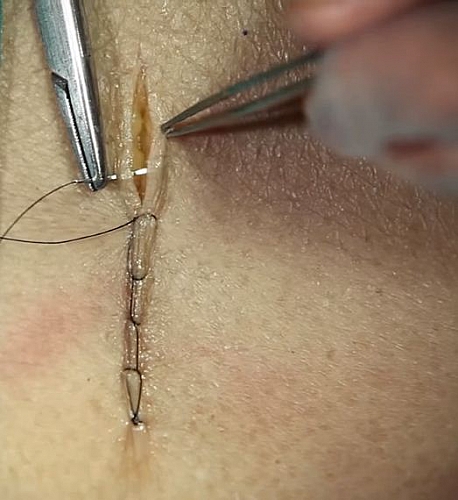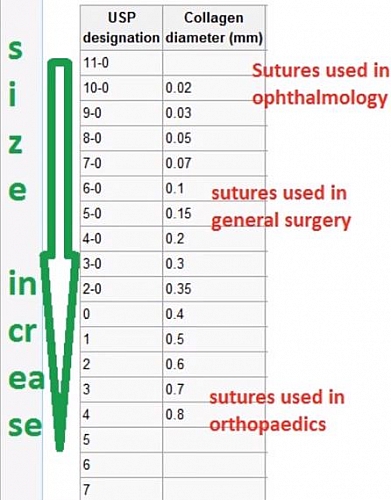Table of Contents
What are Sutures in Surgery?
Sutures are surgical thread like materials used for stitching tissues in surgery. They used to tie, ligate or appose tissue together. There are various types of sutures used during surgical operations and are suited for different purposes depending on the specific type of operation and the type of tissue you intend to stitch during surgery.
Classification of surgical sutures
Sutures can be classified according to the type of material used for making them; according to their ability to be absorbed by the body or either natural or synthetic sutures.
- Absorbable and Non-absorbable sutures
- Monofilament and Multifilament sutures (twisted and braided)
- Natural or Synthetic sutures
- Coated and Non-coated
Types of Sutures according to the materials with associated colors
- Vicryl suture has a purple color
- Nylon suture is green in color
- Silk suture is blue
- Chromic suture is brown
Different types, Indications and Suture Materialsof Surgical sutures
- Plain catgut suture: This is a natural and absorbable form of suture made from submucosa of healthy sheep and serosa of healthy cattle. It is microfilament (single thread) and may be plain or coated with chromic. It contains collagen and causes inflammation which leads to release of protealytic enzymes that digests it in about 5-6 days.
- Chromic catgut suture: A natural absorbable suture with chromic acid added to plain catgut to make it more inert and decreases the chance of having allergic reactions. It poisons the neutrophils and decreases infections and it lasts longer for about 21days. Used in subcorticular closure, for viscera and smell vessels ligation to arrest hemorrhage and for inner layer of bowel anastomosis. Chromic has good handling property, good memory, capillary and low degree of ignition of inflammation (it is inert).
- Reconstituted collagen suture: This is a natural absorbable suture made from serosa of healthy sheep and long tendon of healthy cattle. It is a good suture of the eye in ophthalmology. Other features are similar to catgut but mode of absorption is based on type of manufacturer.
- Vicryl suture: It is a synthetic absorbable suture that is multifilament, braided (rough) and coated with dye for identification. The benefits include good handling, poor memory, decreased capillary and decreased inflammation. It is absorbed by hydrolysis. It can be mounted on a round body or traumatic needle. Vicryl suture is commonly used in ligation of vessels, skin closure, subcutaneous closure, anastomosis of bowel. It is absorbed in 3 months.
- Monocryl: A synthetic absorbable suture that is monofilament made from Vicryl and it is also known as Polyglycoprone. It has all characteristics of vicryl but it is absorbed faster than vicryl and handling is not as good as vicryl. Its memory is intermediate, no capillary action, inflammation is decreased more than vicryl and is absorbed by hydrolysis.
- Silk Suture: This is made from the raw silk from the cocoon of the silk worm. It is natural, non-absorbable multifilament, braided, usually coated with wax, not degraded by proteolysis and undergoes fragmentation. It is dyed with black color. Character includes good handling, poor memory, high capillary (can carry fluid) that is why it is coated with wax, poor inflammation but because of its high capillary, infection can move from place to place, when wet and it gets weaker. Used in outer layer of bowel anastomosis, ligation of very large vessels, used to close skin, ligation of stump in appendectomy.
- Cotton Suture: A natural suture made from cotton buds. It is non-absorbable and used the same way as silk but not braided; it gets stronger when wet.
- Prolene suture: It is a synthetic non-absorbable, polypropylene monofilament suture. Characters include intermediate handling and memory, no capillary effect and inflammation, and anti-thrombogenic (does not form thrombus). Used mainly for vascular anastomosis, other uses include subcutaneous closure, closure of fascia such as midline closure. It undergoes fragmentation.
- Polyester sutures: Synthetic non absorbable sutures
- Polyamine (Nylon): It is a synthetic non-absorbable suture that may be monofilaments or polyfilaments and are black. Characters include poor handling, good memory, none capillary and does not cause inflammation. Used in skin closure, posterior wall repair, apposing fascia, tendon, hernioplasty and subcutaneous skin closure
- Dexon suture (polyglycolic acid): A synthetic delayed absorbable, that is multifilament, braided, not coated and absorbed in 4 months. Characters include good healing, poor memory, poor capillary, non-inflammation and absorbed by hydrolysis. Used in any surgery within the body and skin.
- Polydioxanone (PDS): A synthetic smooth suture that is delayed absorbable, monofilament and lasts longer than dexon. It is absorbed in 6 months; other properties are the same as dexon.
Sizes and Needles of Surgical sutures
Just as in Canula, the higher the number on surgical sutures, the smaller the size. The sizes range from sizes 1.0 to 7.0 but in chromic suture, it is larger than 1.0
Types of Suture needles
- Cutting needles- cross-section is triangular, it is very sharp and/traumatic and is used for skin
- Non-traumatic needle- cross section is round, used for subcutaneous tissue and bowel
Time frame taken for absorption or Removal of Sutures after Surgery
- Non absorbable sutures take about 7-10 days
- Sutures used on the Head and neck can be removed after 3-5 days
- Chest wall and upper limb takes 5-7 days
- Abdomen takes 7-10 days
- Lower limb takes 10-14 days.
These are highly determined by blood supply to the affected area. The more the blood supply, the less the time it takes for the surgical wound to heal, hence the sutures can be removed early.
Qualities of an ideal Surgical Suture
- Should retain its tensile strength until the wound has healed, not affect the tensile strength of the wound
- Should not illicit an inflammation reaction
- Should disappear when the wound has healed
- Should be cheap
- Should not harbor microorganisms
- Should not be toxic or have any carcinogenic substances
Absorption of sutures
1. Enzymatic digestion such as in catgut and collagen sutures
2. Hydrolysis: This uses the effect of water on suture materials. Hydrolysis is increased with increasing temperature
Complications of suture absorption
- Hemorrhage (reactional or secondary hemorrhage)
- Leakage especially in esophageal and colonic anastomosis
- Diverticular formation




